It’s no secret that the French Bulldog is more popular than ever, even though it’s been around since the 1800s. The Frenchie ranks second place in the American Kennel Club’s list of the 202 most popular dog breeds, illustrating how much this breed is adored!
Their increased popularity is partly because celebrities such as Lady Gaga, Reese Witherspoon, Hugh Jackman own them. Fans see this and have to get one of their own.
Also, these tiny dogs are a good fit for our modern lifestyles, especially for apartment and city living. They are compact, portable, and don’t need a lot of grooming. In addition, they don’t bark excessively, they’re playful and affectionate, and they adapt quickly to change. To those who know them, they’re the perfect pooch!
Although they come in several different colors, most Frenchies are brindle, the most sought-after color for many years. However, fashions and trends change, and dog lovers are seeking out some of the more unusual colors, including the Cream French Bulldog.
If you want to know more about this rare little treasure, then read on!
What Is A Cream French Bulldog?
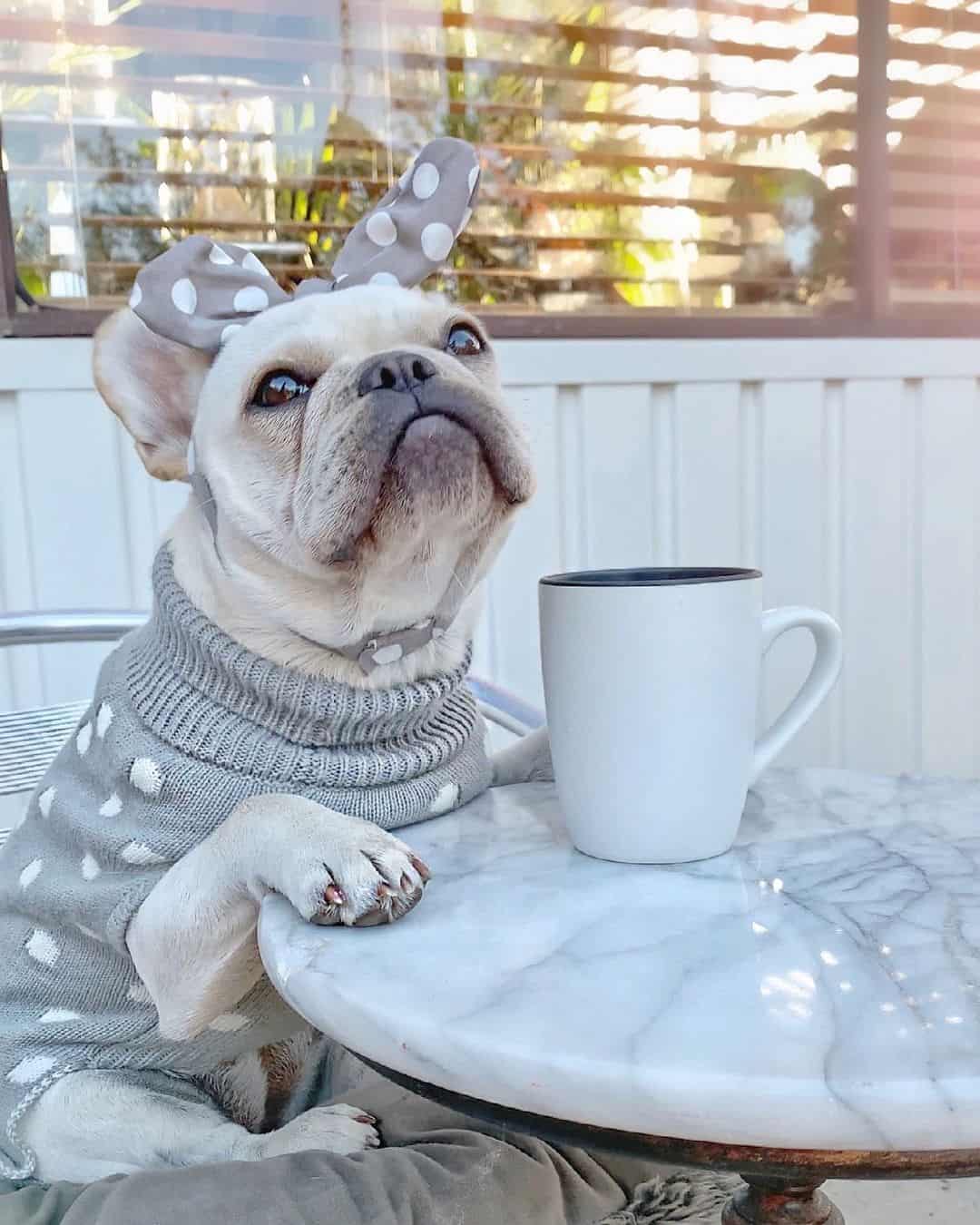
Photo from: @pepsi_and_maxi_pawfashionista
You could say that it’s a light cream color, somewhere between white and fawn. Some breeders refer to it as eggshell. This color is produced by a recessive dilution gene that lightens the fawn coat.
True Cream Frenchies have a solid cream coat without any markings. Some may have a black mask, although it’s easy to mistake fawn Frenchies for the cream-colored version as they tend to display this feature.
Cream Frenchies also have black noses, eye rims, paw pads, and lips. Their eyes should be dark brown, almost black, with no white visible when the dog looks forward.
In some breeds, dogs with cream or white coats are often listed as non-standard, which has led to people avoiding Cream Frenchies as they are concerned about possible health problems (more on this later). They also worry that their dog will be banned from shows or penalized for being outside the breed standards.
The good news is that the AKC includes cream in its coat colors for the French Bulldog. Here’s that list in full:
• Brindle
• Brindle and white
• Cream
• Fawn
• Fawn and white
• Fawn, brindle, and white
• White
• White and brindle
• White and Fawn
They can also display any of these markings:
• Ticked
• White
• Black mask
• Black
• Piebald (or pied)
• Brindle
So, if you’re after a Cream French Bulldog, you can relax, as it’s on the list! Of course, this won’t worry those who don’t plan to enter their dog in shows.
However, it’s still wise to be cautious about specific colors as they can affect the dog’s health. It’s also believed that coat color can affect temperament, although some experts dispute this.
Cream French Bulldog Puppy
These are just the sweetest little things!
They have blue eyes at first (see below for more details). Their noses and paw pads darken to become solid black, usually within 24 hours. Their smooth, glossy coats are solid cream, but this color may lighten as the pup develops.
French Bulldogs have a long history of severe health problems, so they need extra care and attention.
Tips On Grooming And Care:
• Bathe them regularly – Skin infections and allergies are a real problem, especially for Cream French Bulldogs, so it’s good to keep their skin clean and hydrated. Don’t use human shampoo, not even baby shampoo, as the pH balance is wrong. You can buy unique skincare products designed for dogs to reduce the risk of allergies and infections.
• Don’t forget the tail pocket – Frenchies have a short, stumpy tail, beneath which you might find an indentation. Wrinkles cause this dip in the skin, possibly trapping dirt and feces. It’s a good idea to gently wipe this area after the dog has been to potty.
• Regular mealtimes – Feed your pup small meals three times a day to ensure it develops properly and to maintain its energy levels. It will also stop them from gorging their food all at once, reducing the risk of digestive problems. The Frenchie’s squished face also causes it to swallow air along with the food, which bloats the stomach and gives them gas. Smaller meals provided more regularly will help to ease this.
• Grooming – Start the grooming process as early as possible, as this helps them get used to it. This includes brushing, nail clipping, brushing teeth, and cleaning the dog’s ears about once a week.
In general, these cute little dogs aren’t high maintenance, but they do need and deserve a bit of extra care to compensate for some of the problems they face.
After all, it’s the least we can do for them!
Cream French Bulldog Price
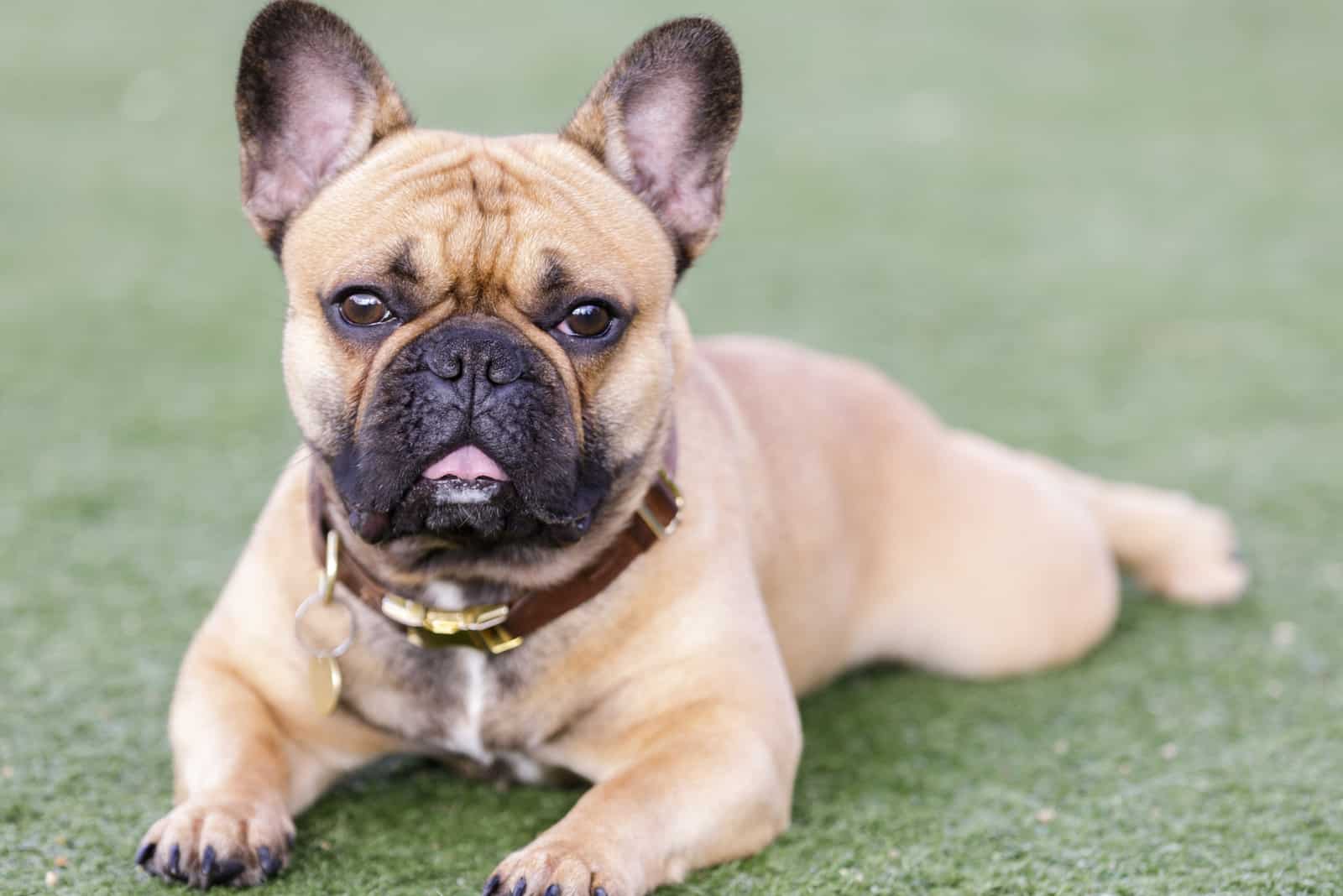
You should expect to pay between $1,600 and $3,500 for your Cream French Bulldog. For top-quality breeding lines, you might be looking at between $5,000 and $10,000.
It isn’t easy to find exact prices for a particular breed, as these are affected by several factors.
For example, reputable breeders with excellent bloodlines will charge higher prices because their breeding program involves more expense. The price will also be affected by location, demand, and the sex or color of your dog.
On that last point, ethical dog breeders generally don’t play on the fact that some colors are rare. Even so, they may raise the price slightly to recover some of the expenses of breeding. One thing good breeders never do is breed specifically to get a particular color.
The Frenchie’s popularity also affects its price. The higher the demand, the more breeders will charge – that’s how business works!
Before Buying Your French Bulldog Pup
However, always be cautious when buying a dog. Too many unscrupulous people are willing to take your cash, which is bad news for your bank account, but even worse for the dogs. Although thousands of online scams involve fake websites and ads for non-existent puppies, many real pups for sale online are produced in puppy mills.
There are around 10,000 puppy mills in the US, where dogs are kept in miserable conditions. They are not cared for, never experience love or affection, and live in filthy kennels until they are no longer useful. Most puppy mill pups are sickly, poorly bred, and will cost you a packet in vet bills.
While you might think reputable breeders charge too much, breeding is an expensive business when done correctly. When you buy from a reputable breeder, you know that the parents and pups have been treated well and tested for common health conditions. Your dog has an excellent chance of being healthy and living a long and happy life.
Blue Cream French Bulldog
You won’t see Blue Frenchies in the AKC standard coat colors we listed earlier!
It’s a fantastic shade, more a slate gray than blue, but very appealing nonetheless.
Although brindle is the most common color, rare colors (like blue) appear to be growing in popularity. While they are lovely to see, this isn’t necessarily a good thing.
The mutated gene that creates the Blue French Bulldog’s coat is recessive, meaning that the puppy needs to inherit a copy from each parent for this color to have a chance of showing up. Many breeders are opposed to using dogs that carry this gene in their breeding programs as they are believed to increase the risk of certain diseases and health conditions.
Cream French Bulldog With Blue Eyes
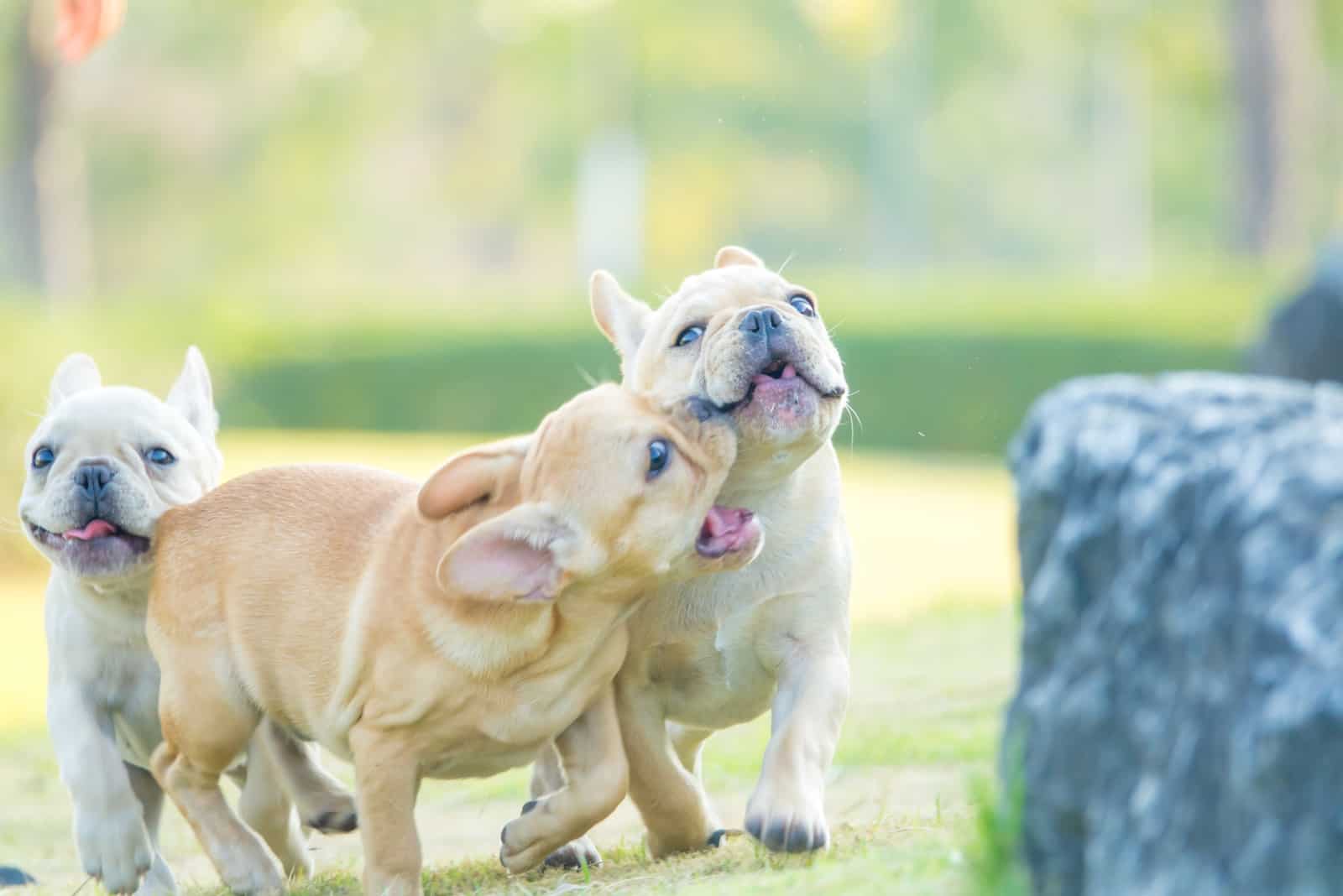
All puppies start with blue eyes, and the Frenchie is no different. In most cases, they tend to change color after several weeks, usually turning brown, although green and amber are present in some breeds.
After about ten weeks, the Frenchie’s stunning blue eyes will probably change to brown. It’s a slow process, but soon there will be no trace of the blue it was born with. Even so, some French Bulldogs’ eyes stay blue throughout their lives, and these are beautiful.
However, you’ll only find these associated with specific coat colors, like merle, blue, lilac, and isabella.
As you might notice, none of these colors are included in the AKC breed standard!
Sadly, blue eyes are not permitted either, probably to reduce the risk of further health problems.
Chocolate Cream French Bulldog
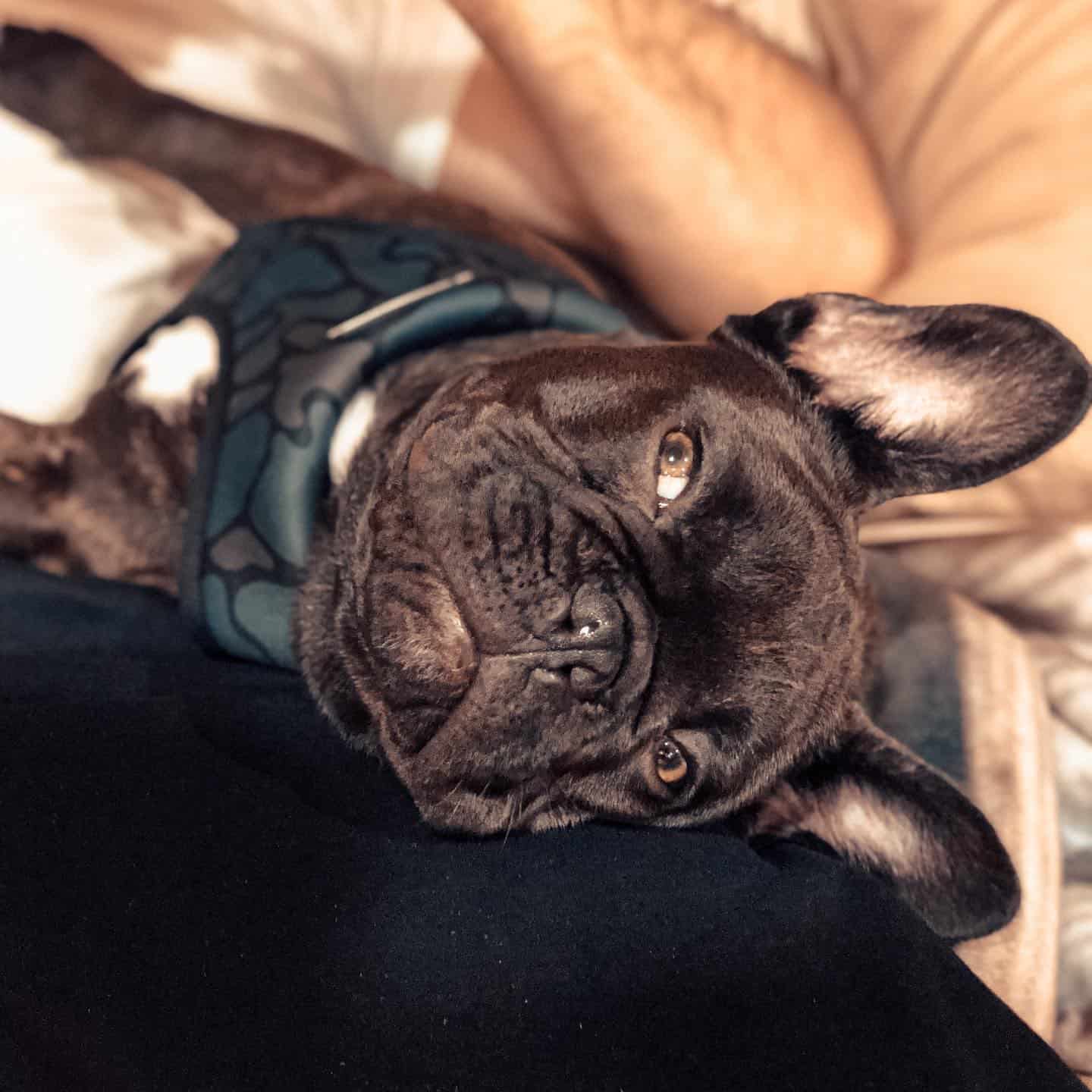
Photo from: @mario.the.frenchie
Although the first part sounds like some kind of confectionery, it’s a stunning and rare Frenchie coat color!
You can read more about rare colors further down, and the chocolate cream version is included there.
Cream Frenchies are pretty rare anyway, but to get a chocolate and cream dog takes some doing. A pup will have to inherit two copies of the gene that dilutes black to brown to be chocolate. In dog color genetics, the dog will be recorded as b/b, referring to a recessive allele passed to the pup by both parents.
The E-locus creates the cream color, so if both parents pass this onto the pup, it will be e/e and have a light cream coat. Oddly enough, the E-locus is dominant over all other colors! Any dog that possesses two copies of this gene will be completely cream, regardless of what other colors might be present.
Lilac Cream French Bulldog
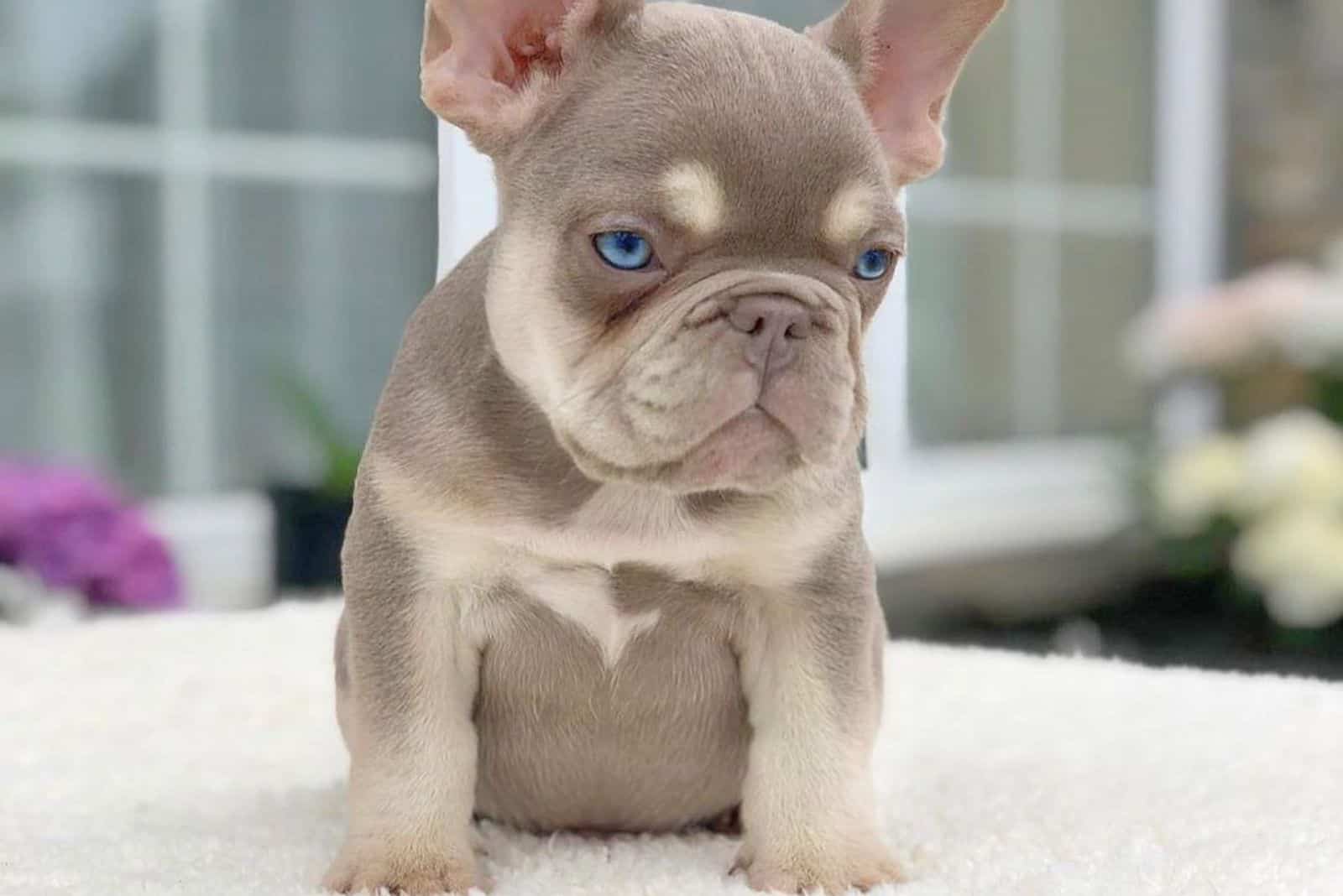
Lilac French Bulldogs are breathtaking, with a silvery-blue appearance. To the untrained eye, they look much like the blue version. However, when seen side by side, the difference is clear.
This fantastic color, caused by a recessive gene, dilutes both the chocolate (liver) and the blue coat and is also referred to as isabella.
Taking this one step further, Lilac Frenchies with the dilution gene will appear much lighter, usually with blue eyes. These dogs are known as Lilac Cream French Bulldogs.
Cream Pied French Bulldog
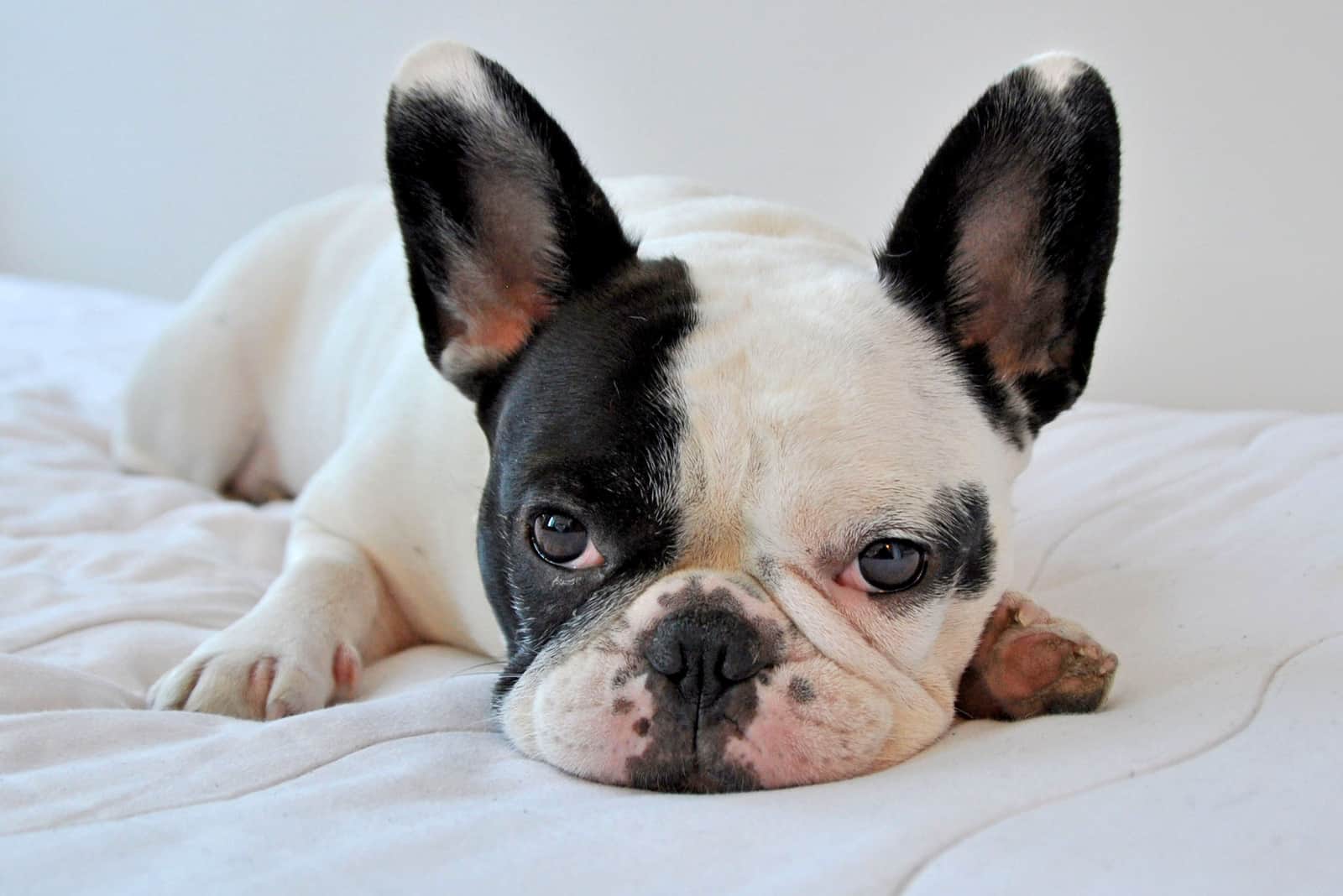
Here’s another name that sounds like dessert!
As we referred to earlier in the AKC breed standards, a pied dog is the same as a piebald. For Frenchies, the term pied is mainly used.
First, what is a Pied French Bulldog?
You’ll probably have noticed that the word was listed in the markings section of the breed standards rather than the colors. That’s because pied dogs are usually 50/50 white and any other color.
Therefore, you can have a white dog with black patches covering the body, including the head and neck. These black and white dogs are in demand, possibly in second place after brindle.
A Cream Pied Frenchie doesn’t have black or white on its coat. Instead, the cream base has light fawn patches. Like many of the other colors here, it’s pretty rare!
Do Cream French Bulldogs Have Health Issues?
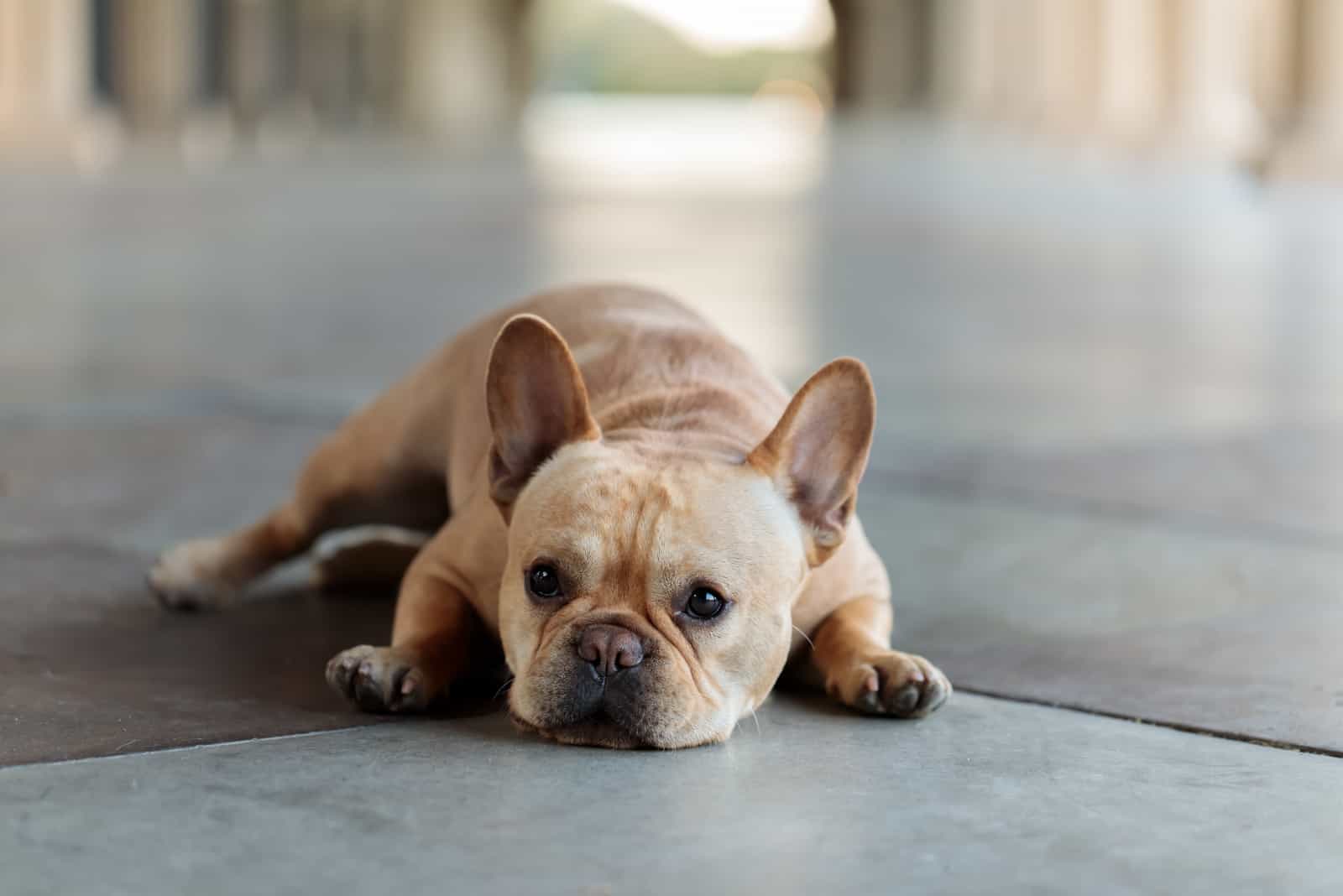
All dog breeds suffer from health problems, although some are worse than others.
French Bulldogs are more prone to certain health issues because of their size and shape.
Here’s a list of the more common ones:
• Breathing problems – French Bulldogs of any color are brachycephalic, meaning they have a short muzzle and flat face. As dogs naturally have a long muzzle, this feature – a result of selective breeding – causes significant health concerns. The airways are crammed into the skull, causing breathing difficulties that may lead to fainting, collapse, and death.
• Dental problems – Due to their short muzzles, the Frenchie’s teeth are crammed into the mouth, and some may need extracting to make more room. It’s a painful condition that can lead to other complications, such as infections and ulcers.
• Eye conditions – The Frenchie’s misshapen skull and flat face predispose it to have potentially severe eye issues, as the eye sockets are too shallow (known as brachycephalic ocular syndrome). This causes the eyes to bulge, making them prone to injury from knocks and scrapes. They might even come out of the socket if the dog hits its head. Ulcers also occur when the eye dries out because the eyelid doesn’t close fully.
• Hip dysplasia – Most breeds suffer from this painful problem, particularly large breeds. The French Bulldog is prone to hip dysplasia because of decades of deliberate breeding. The problem is caused by a malformed hip joint that allows the bones to grate against each other, making movement difficult and uncomfortable. Surgery is often needed in severe cases.
• Heart problems – Heart murmurs are pretty common in young pups, and heart diseases often affect older dogs, especially those that are obese, have a poor diet, or don’t get enough exercise.
• Floating kneecap – A luxating patella can cause discomfort as the kneecap slides out of place. The kneecap usually slots into a groove in the bone. When it slips out of place, it stops the dog from extending its knee fully.
• Birthing difficulties – Like all Bulldog breeds, the Frenchie has a large head and broad shoulders, making it almost impossible for females to give birth naturally. The danger of pups becoming stuck in the birth canal is too much of a risk, so most French Bulldogs are born by C-section. Although safer, this method is not without its risks.
• Skin infections – While many people love a dog with a wrinkled face, those deep folds of skin are a breeding ground for bacteria. Natural oils, dirt, sweat, and saliva become trapped inside, making a perfect environment for germs to thrive.
• Allergies – French Bulldogs are highly prone to allergies connected with food and environmental triggers. While some allergic reactions are mild, they still make life uncomfortable for your furry friend. However, some reactions can be severe, resulting in anaphylactic shock, which can be fatal.
Sadly, the Cream French Bulldog has an even greater risk of allergies because of its color. There is also a chance that they’ll suffer from alopecia (hair loss). It all comes down to coat color genetics.
Each color is connected with a specific locus (the location of the gene in the chromosome), and although we know more than we used to, there’s still a lot more work to be done to get a complete understanding of the subject.
However, we know enough to be convinced that some colors and patterns are bad news!
Coat Color Pigments
Dogs get their colors from two pigments: eumelanin and pheomelanin. These tell the cells in the hair follicles which colors to produce. When the genes don’t instruct the cells to make any color, the coat will be white. Many people have concerns about the White French Bulldog as they believe that all white dogs are albino.
However, very few white dogs are true albinos! Albinism carries a severe risk of blindness, eye damage, skin cancer, and light sensitivity. A true albino dog’s nose and eyes will be pink, and its coat will be pure white.
You can take some comfort in the fact that the White Frenchie is listed in the AKC breed standards, as they usually bar any colors that carry a health risk.
The Merle French Bulldog
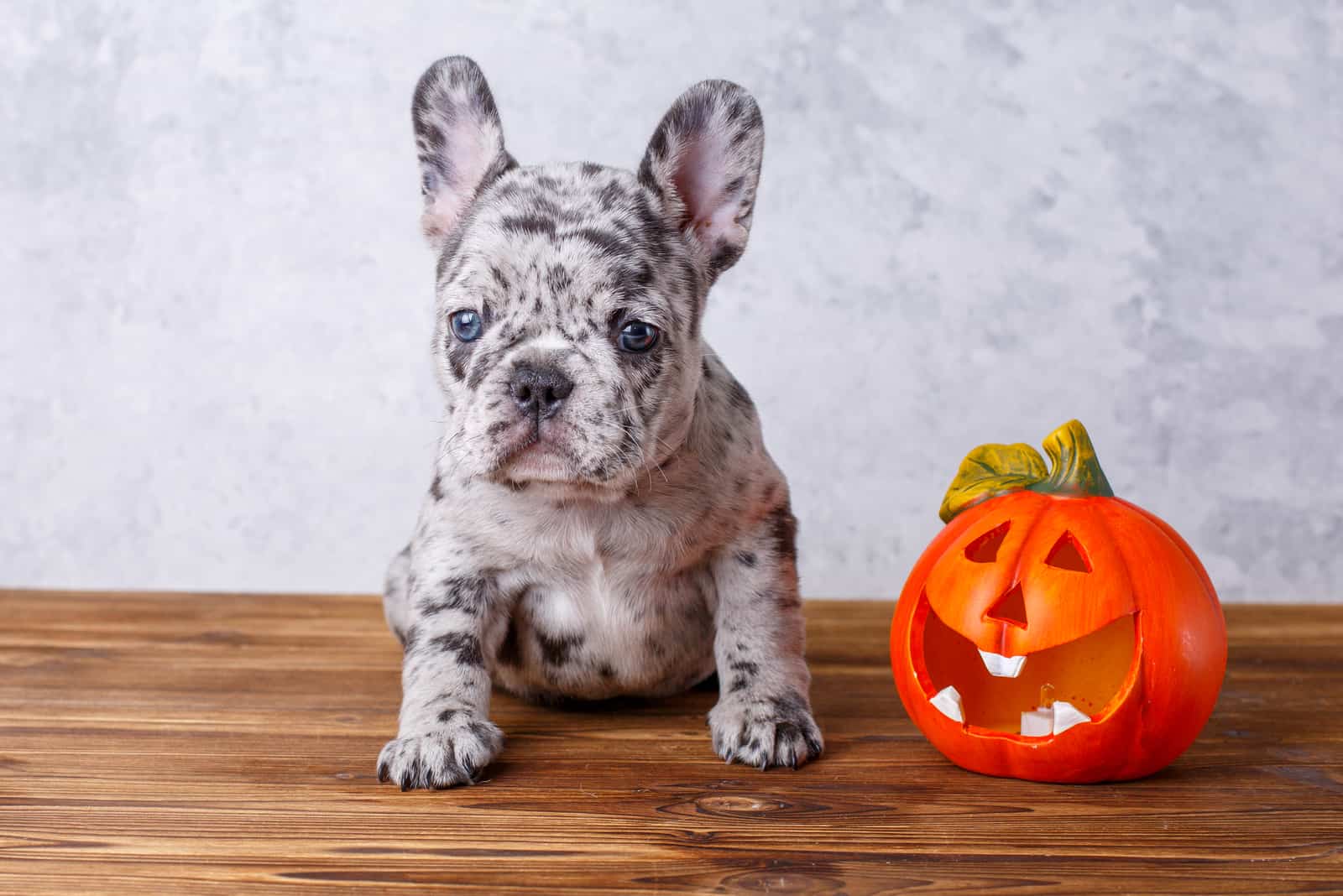
Of all the French Bulldog colors, merle is the most controversial. In truth, some colors should be labeled color patterns, and merle fits this category, along with sable and brindle.
Merle is a beautiful addition to the Frenchie’s palette. It affects most of the Frenchie’s different colors, and each pattern is unique.
Sadly, however, it seems to be linked to severe health issues.
The merle gene responsible for the random, mottled pattern that appears on piebald (or pied) and solid color coats can also affect skin pigment, as well as the structures that form the eyes and ears. When two merle dogs are bred, pups that inherit this gene may suffer from deafness and eyesight problems.
Many merle dogs have blue eyes, and some have one blue and one brown eye. As unusual and beautiful as this is, any dog with these qualities is banned from shows.
For the sake of clarity, the merle gene rarely causes problems unless two merle dogs are bred.
What Is The Rarest French Bulldog Color?
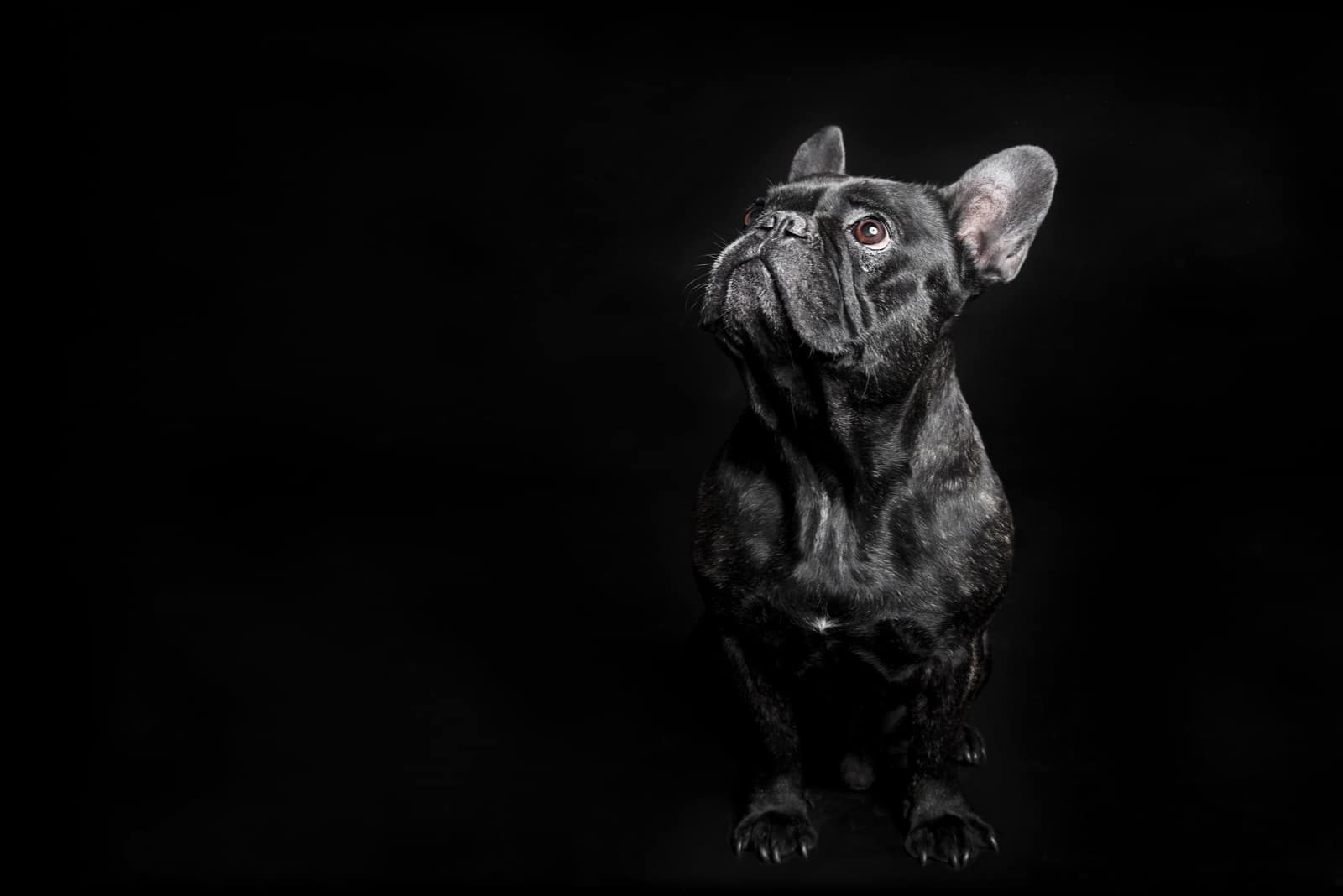
The jury is still out on this one!
Many experts claim that the solid black Frenchie is the rarest, while others point to fascinating colors like blue, chocolate, merle, and lilac. If you’re lucky, you might even find a black and tan French Bulldog! Try Googling some of these, and you’ll find far more examples of black Frenchies than most others. By comparison, we only found one instance of a Chocolate Cream French Bulldog!
You also hear about such oddities as the blue merle, blue fawn, blue pied, blue brindle, lilac cream, chocolate cream, and so on.
The truth is that all of these are rare colors, and it isn’t easy to pick which is the rarest as some of them turn up unexpectedly while others are planned. There are also suggestions that specific rare colors are achieved by creating hybrids with other dogs, like the Pug.
A good breeder might produce one or two litters a year. The average Frenchie litter is three pups. So, out of six puppies in one year, only one of these might be a rare or unusual color.
As we already mentioned, good breeders don’t breed purely for color, it’s all about health, temperament, and form. Few breeders have the knowledge or expertise to create these beautiful colors successfully while ensuring that the pups don’t have even more health problems.
The irony is that most of the rarer colors are considered ‘undesirable’ by the AKC, but the truth is that these colors are becoming more popular by the day!
Finally, we have to include the Cream French Bulldog in the list of rare colors. You don’t see as many of these as the brindle or fawn color.
Cream French Bulldogs: The Future
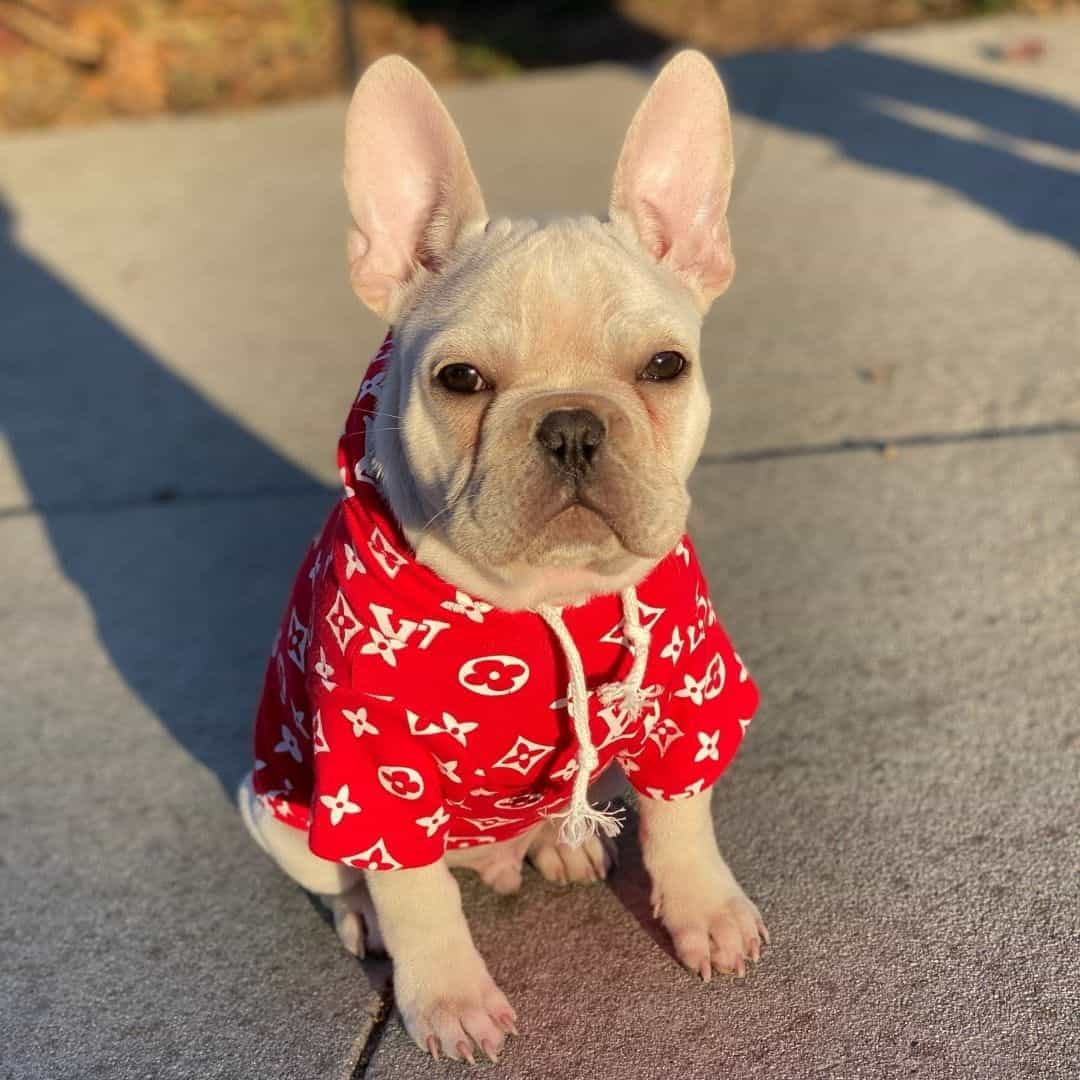
Photo from: @ace_thefrenchbulldog_
No one can deny that the French Bulldog is cute with bat-like ears and scrunched-up wrinkled features. These lovely come in a fantastic array of colors, though some of the less common ones are considered non-standard and undesirable.
The Cream French Bulldog isn’t as frequently seen as others, like Brindle and Fawn French Bulldogs. However, its light color appeals to people, and it has recently become more popular.
Social media is probably the biggest driver of trends and fashions these days, and, rightly or wrongly, dogs have become fashion accessories as well as pets. As awareness of different breeds or unusual colors spreads across social media pages, demand for particular dogs rises.
So, while the brindle French Bulldog is the most common color and has been for some time, this could change soon. Just like any other business, the world of dog breeding is driven by demand, and if nobody buys brindles, then they’ll stop breeding them.
This is why many breeders, kennel clubs, and purebred dog enthusiasts believe that people should avoid breeding and buying dogs outside of the breed standards. They think that the whole point of purebred dogs is to preserve and improve the breed, and creating unusual colors, they argue, could jeopardize the breed.
It has to be said that they make a good point, especially as there’s already a good variety of colors and patterns within the breed standard. We should also consider the health implications of creating unusual colors, particularly where the merle gene is concerned.
Even so, it’s understandable that people love those crazy colors, like blue cream, chocolate cream, isabella, and lilac cream.
In the end, the public will decide the Frenchie’s fate. As fashions and fads come and go, it might be that the French Bulldog falls from favor, outdone by another adorable breed.
However, the Cream French Bulldog is safe – for now. It’s a rare color, but it falls within the breed standard. It can be a lapdog, show dog, or both! As long as dog lovers buy them, the breeders will produce them.
In conclusion, we have to keep in mind that Frenchies have in-built health problems. While breeders and kennel clubs frown on any deviations from the standards, often citing health concerns, it has to be said that these little dogs are already at a disadvantage. Many animal welfare groups question whether it is ethical or fair to continue breeding them at all.
Before you buy one, consider that they are predisposed to health conditions that will require many visits to the vet. As they can live for between 10 and 14 years, this can amount to money and stress!
If you think you’re up to it and can provide a loving home for one of these beauties, then head to a reputable breeder or local Frenchie rescue group to get your Cream French Bulldog while you can. There’s a chance that they might not be around in the future.
Read Next:
• French Bulldog Growth Chart: How Big Can A Frenchie Get?
• 8 Best French Bulldog Breeders In Oregon: A Safe Buy















